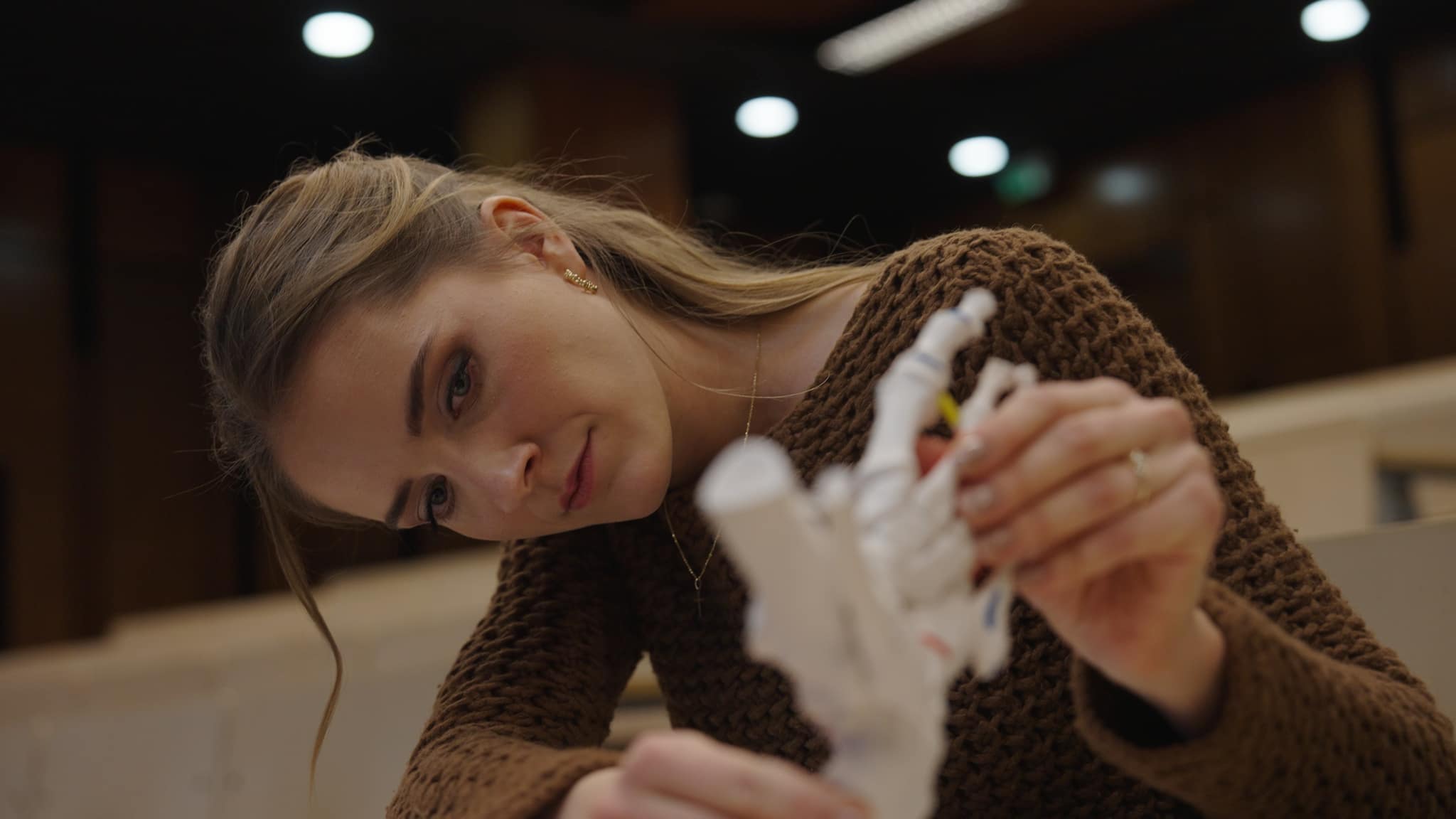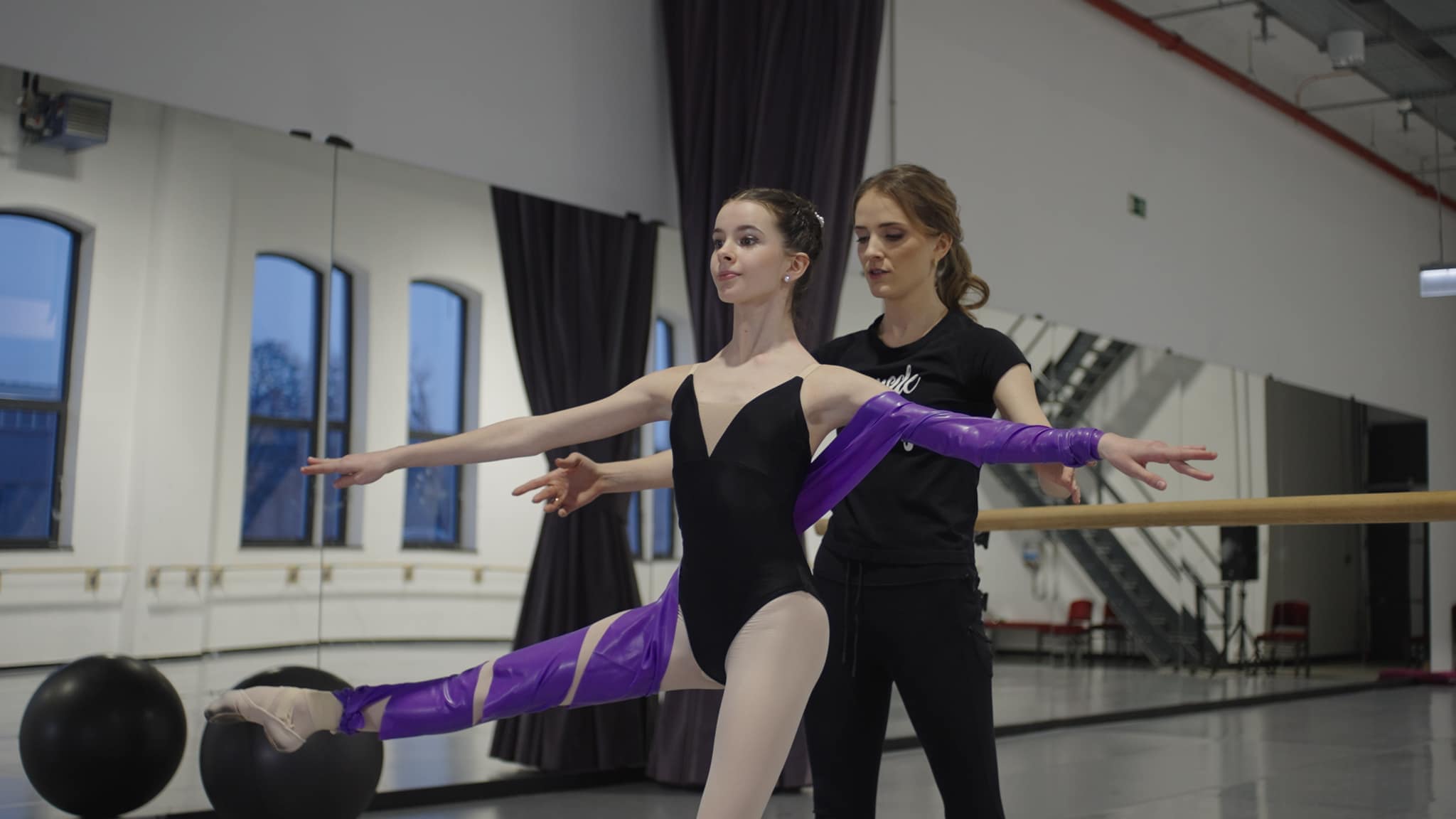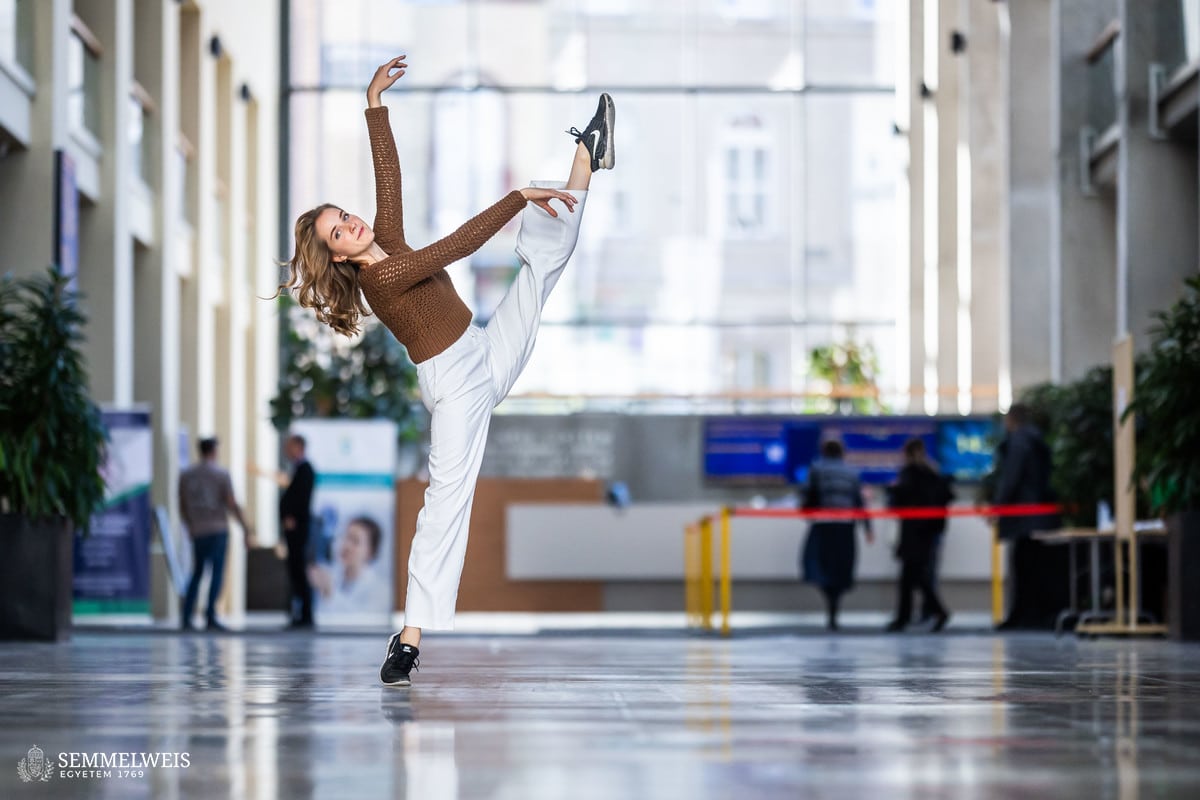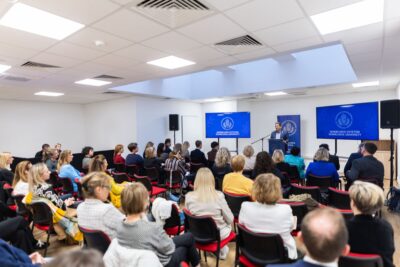 “I was nine years old, standing on the stage of the Opera House, holding a nutcracker doll, and then, following my hand movement, the curtain fell. That moment will stay with me forever,” recalled Noémi Verbőczi, who danced with some of the world’s leading ballet companies, but was most deeply affected when her childhood dream of performing in The Nutcracker came true. “I prayed for this every night. When I finally got my first leading role, I felt even as a child that this was a defining moment. It taught me that you have to work hard every day and believe in yourself,” she said.
“I was nine years old, standing on the stage of the Opera House, holding a nutcracker doll, and then, following my hand movement, the curtain fell. That moment will stay with me forever,” recalled Noémi Verbőczi, who danced with some of the world’s leading ballet companies, but was most deeply affected when her childhood dream of performing in The Nutcracker came true. “I prayed for this every night. When I finally got my first leading role, I felt even as a child that this was a defining moment. It taught me that you have to work hard every day and believe in yourself,” she said.
There are no doctors or dancers in her immediate family, nor even athletes or artists. “My parents have founded and operated a mattress biomanufacturing company for more than 30 years – they taught me the importance of hard work and perseverance and the philosophy of always doing things to our best. So, my passion for dance did not come from them. My sister and my friends danced jazz in kindergarten, but I couldn’t pronounce it at the age of three, so I said I wanted to dance jams, too,” she says about her beginnings. Her teachers recognized her talent, and she enjoyed dancing, so she persevered. She was already in fourth grade when her artistic gymnastics teacher suggested that she apply to the Hungarian Dance University. “We didn’t even sign up in advance, my dad and I just jumped on the motorbike one Saturday. They didn’t know who I was or what I wanted, but they gave me an opportunity to show what I was capable of. As my father recalled, after the admission exams, the rector addressed the parents and announced that they wished to speak with Noémi Verbőczi’s parents. ‘We need this little girl,’ they told my father,” she tells her story. Her parents initially had reservations about a career in ballet but ultimately gave their blessing. She began the ten-year training program at the Hungarian Dance University at the age of nine.
Noémi Verbőczi has shared that she found attending ballet classes alongside elementary school and high school to be extremely demanding – that required not only diligence but also great perseverance. Ballet classes started at 8 a.m., but she was already in the studio at 7 a.m. to warm up and put in the extra work that is necessary to make progress in ballet. The technical classes finished at 2 p.m., after which she was at school until the evening, and then rehearsals for the current performance began. “I don’t even know how I managed to pass my school-leaving exams with honors while also performing in the world’s biggest competitions,” she added. When asked what it takes to become a professional ballerina rather than an amateur dancer, she replied that it was a complex equation with many factors.
Of course, it requires natural talent, but you also have to make good use of what God has given you. The other prerequisite is hard work. You also need role models and that extra something that’s beyond our control. Whatever you call it – a blessing or luck – it’s also essential for success.
 After graduating from the Hungarian Dance University, Noémi Verbőczi had several career opportunities to consider. “I was accepted into the Hungarian State Opera, as well as the ballet companies in Monte Carlo and Dresden. I chose Dresden. After one season, I was offered a contract with Stuttgart Ballet, widely considered to be the third best ballet company in the world at the time. It was a huge honor because the last time a Hungarian dancer performed there was 10 years earlier. I was incredibly happy – and yet terribly unhappy at the same time. As a ballet dancer, you don’t even have time to have a cat, let alone maintain relationships with family and friends. However, these are very important to me. In fact, I felt that these were more important than sacrificing everything for ballet. After much thought, I realized that I only had one life. Even though I had reached the pinnacle of ballet, I didn’t want dance to be my only focus. I had been doing this since the age of three, but one morning, I woke up and decided to stop,” she said, highlighting one of the turning points in her life.
After graduating from the Hungarian Dance University, Noémi Verbőczi had several career opportunities to consider. “I was accepted into the Hungarian State Opera, as well as the ballet companies in Monte Carlo and Dresden. I chose Dresden. After one season, I was offered a contract with Stuttgart Ballet, widely considered to be the third best ballet company in the world at the time. It was a huge honor because the last time a Hungarian dancer performed there was 10 years earlier. I was incredibly happy – and yet terribly unhappy at the same time. As a ballet dancer, you don’t even have time to have a cat, let alone maintain relationships with family and friends. However, these are very important to me. In fact, I felt that these were more important than sacrificing everything for ballet. After much thought, I realized that I only had one life. Even though I had reached the pinnacle of ballet, I didn’t want dance to be my only focus. I had been doing this since the age of three, but one morning, I woke up and decided to stop,” she said, highlighting one of the turning points in her life.
“I quit my job, returned home, and immediately felt that I had to do something with myself – but until then, I had lived almost exclusively for ballet, so it wasn’t easy to figure out what I should do next. I tried my hand at several things, including babysitting and even working as a cleaner. Ultimately, I decided to retake my high school exams and in 2019 I applied to study physiotherapy at Semmelweis University’s Faculty of Health Sciences. I felt that this was the closest to ballet, so I could stay in the field, but in a different way – this time through helping others. That’s how I discovered dance medicine,” she explained.
As for her studies, she is most proud of her National Student Research Conference (OTDK) research conducted at Semmelweis University: She worked on improving the balance of ballet students at the Hungarian Dance University. “I studied in Cuba for a short time on a dance scholarship, where I experienced firsthand how Cubans are innately talented in spinning. There are some people in Hungary who are exceptionally good at this, too, but they are not the majority. I investigated how much this skill can be enhanced through balance training, and my research showed that significant improvement can be achieved,” she pointed out. She won several recognitions, including first prizes at the Students’ Scientific Conference (TDK), the National Student Research Conference, and the Special Award of the Association of Hungarian Physiotherapists. The research was supported by the New National Excellence Program. Later, thanks to a scholarship from the Ödön Kerpel Fronius Talent Development Program, she had the opportunity to present her findings in the United States, and, in recognition of her outstanding academic and professional achievements, she was also awarded the National Higher Education Scholarship by the Ministry of Culture and Innovation. “It was thanks to the university’s innovation center that I had the chance to visit Australia for the first time. As a child, I dreamed of becoming a soloist at the Sydney Opera House, but I never had the opportunity to audition there. However, with support from Semmelweis University, I was able to travel to Sydney, where I felt that this dream of mine was coming true – not as a dancer, but as a physiotherapist working with the Australian Ballet’s physiotherapy team,” she recalled.
 While in Australia, she caught the attention of the head of Progressing Ballet Technique (PBT). This physiotherapy-based program is designed for ballet dancers and aims to promote ballet-specific development, rehabilitation and injury prevention, while taking into account the extreme and unnatural strain placed on ballet dancers. Noémi Verbőczi became the European representative, ambassador, and master instructor of this technique. She has trained close to a hundred PBT teachers in Hungary, but also regularly travels the world to deliver additional training courses. “It took me a while to get back into dancing because ballet is extremely demanding, both physically and mentally. I had to process all its beautiful and difficult aspects. But I realized that I couldn’t and didn’t want to completely break away from my roots. I recognized the enormous potential in the fact that, having been a dancer myself, I could really help other dancers as a physiotherapist,” she pointed out.
While in Australia, she caught the attention of the head of Progressing Ballet Technique (PBT). This physiotherapy-based program is designed for ballet dancers and aims to promote ballet-specific development, rehabilitation and injury prevention, while taking into account the extreme and unnatural strain placed on ballet dancers. Noémi Verbőczi became the European representative, ambassador, and master instructor of this technique. She has trained close to a hundred PBT teachers in Hungary, but also regularly travels the world to deliver additional training courses. “It took me a while to get back into dancing because ballet is extremely demanding, both physically and mentally. I had to process all its beautiful and difficult aspects. But I realized that I couldn’t and didn’t want to completely break away from my roots. I recognized the enormous potential in the fact that, having been a dancer myself, I could really help other dancers as a physiotherapist,” she pointed out.
She has learned to appreciate the simple things in life: “I finally have time for myself, my friends, and my family. On Sundays, I can spend hours cooking my grandmother’s chicken stock, sit down to read, and I’ve even started knitting. As a dancer, I could never have imagined such things. I was at the theatre seven days a week, from morning until night. I still travel a lot for work, and although I don’t receive loud feedback like applause, I feel great joy when I see someone improve visibly and spectacularly thanks to my work.”
Noémi Verbőczi is currently a second-year student at the Faculty of Medicine. She enrolled in general medical training because she wants to help people and feels that she needs to learn and research more to do so. “I am a perfectionist, so I try to do my best with the tasks that life gives me. Although I am working on tempering my pursuit of excellence, I still felt that medicine was the right path for me. Physical therapy primarily deals with the musculoskeletal system, but humans are much more than that. I want to see the human body – especially that of a dancer – in a complex way, in its entirety,” she explained.
Her long-term goal is to train as many physically and mentally healthy dancers as possible, both in Hungary and abroad.
“Right now, I feel like I’m in a good place in my studies, my work, and my life in general. I’m working on making the most of my situation and opportunities,” she added.
Ádám Szabó
Translation: Judit Szabados-Dőtsch
Photos by Bálint Barta – Semmelweis University; Star Network, dm Ltd.; Gregory Bratardon






